UPSC Daily Current Affairs- 24th August 2023 | Current Affairs & Hindu Analysis: Daily, Weekly & Monthly PDF Download
GS-I
Fujiwhara Effect: When cyclones dance
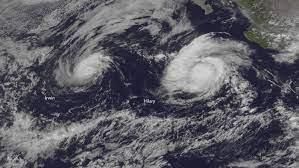
Why in News?
- Surprising Weather: Recently, a storm named Hurricane Hilary brought a tropical twist to the US west coast. It’s part of a series of odd weather happenings there.
- Wet Weather: Earlier this year, California had an unexpected rainy season with lots of wet storms, called ‘atmospheric rivers.’
- Fujiwhara Show: During one of these storms, something special occurred—an effect named after a scientist.
Decoding the Fujiwhara Effect
- Cyclone Waltz: Imagine two cyclones (or big storms) spinning in the same direction. When they get close, they begin a kind of dance around a common center.
- Outcome of the Dance: Depending on the strength of the cyclones, they might merge, spin together, or one might absorb the other.
- Super Cyclone: Rarely, if both cyclones are super strong, they can become one mega cyclone that causes big trouble.
Historical Context and Impact
- Origins and Discovery: The Fujiwhara effect got its name from a Japanese scientist who first talked about it in 1921. It was seen happening for real in 1964.
- Effects Unleashed: This unusual dance can be fierce. It has caused strong winds, broken windows, and power problems in some areas.
- Guessing Game: The Fujiwhara effect is tricky for weather experts. It’s hard to predict what will happen when two cyclones dance together.
Climate Change Connection
- More Frequent Moves: The Fujiwhara effect is showing up more often now. Experts believe it’s because our world is getting hotter and ocean waters are warming up.
- Hotter Waters: Because of global warming, storms are getting stronger. For instance, in Taiwan, typhoons have become 35% stronger since 1977 due to warmer oceans.
Implications
- Nature’s Symphony: The Fujiwhara effect is like a nature’s concert, showing us how everything is connected in our climate.
- Future Twist: As storms get more powerful, the Fujiwhara effect could become even more important and harder to understand.
- Planet’s Dance: The Fujiwhara effect teaches us about our planet’s rhythm and how important it is to take care of our home.
Source: The Indian Express
GS-II
Katchatheevu Island
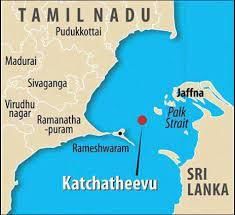
Why in News?
Recently, the Tamil Nadu Chief Minister revived the debate over the Katchatheevu, a longstanding point of contention between India and Sri Lanka, particularly with regard to fishing rights and sovereignty over the uninhabited island.
What are the Highlights of the Katchatheevu Issue?
- Historical Background:
- Katchatheevu is a 285-acre uninhabited speck in the Palk Strait, between India and Sri Lanka, an island located about 14 nautical miles off Rameswaram,India.
- In 1974, Prime Ministers Indira Gandhi of India and Sirima R.D. Bandaranaike of Sri Lanka signed an agreement that recognized Katchatheevu as part of Sri Lanka's territory, resulting in a change of ownership.
- The agreement also allowed Indian fishermen to fish around the island, dry their nets on it, and permitted Indian pilgrims to visit the Catholic shrine located on the island.
- Fishing Rights and Livelihood:
- Fisherfolk from both India and Sri Lanka have historically used Katchatheevu for fishing. Though this feature was acknowledged in the 1974 agreement, the supplemental pact was signed in 1976.
- The 1976 agreement was aimed at defining maritime boundaries and exclusive economic zones for both countries, while also imposing restrictions on fishing vessels and fishermen from either nation, prohibiting fishing in each other's waters without explicit permission from either of the two countries.
- Fisherfolk from both India and Sri Lanka have historically used Katchatheevu for fishing. Though this feature was acknowledged in the 1974 agreement, the supplemental pact was signed in 1976.
- Indian Government Stance and Legal Aspects:
- The Indian government, in 2013, stated that the question of retrieval did not arise as no Indian territory was ceded.
- The issue was framed as a dispute between British India and Ceylon (now Sri Lanka), resolved through agreements in 1974 and 1976.
- The Union government asserted that Katchatheevu lies on the Sri Lankan side of the India-Sri Lanka International Maritime Boundary Line.
- Political and Public Sentiment:
- The transfer of Katchatheevu triggered opposition and debates in both Indian Houses of Parliament.
- Leaders of Tamil Nadu have periodically raised the demand for the island's retrieval.
- The demand evolved over the years, with suggestions of a "lease in perpetuity (a lease deed in which no specified time period)" for the island.
Source: The Hindu
Bharat New Car Assessment Programme
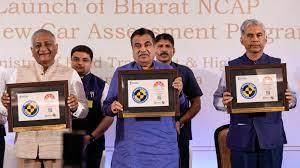
Why in News?
- The Ministry of Road Transport and Highways has rolled out an indigenous star-rating system for crash testing cars.
- Under the new system, vehicles will be assigned between one to five stars indicating their safety in a collision.
- Called the Bharat New Car Assessment Programme (NCAP), the rating system will be voluntary and will come into effect from October 1, 2023.
What is Bharat NCAP?
- About:
- It is a testing protocol, wherein automobiles in India shall be accorded Star Ratings based upon their performance in crash tests.
- Under the Bharat NCAP, cars voluntarily nominated by automobile manufacturers will be crash tested as per protocols laid down in the soon-to-be-published Automotive Industry Standard 197.
- The testing protocols adopted by the Bharat NCAP are modelled on the Global NCAP.
- While India has mandatory crash test norms for cars, the Bharat NCAP rating will be of superior standard and will be aligned with global crash-test protocols.
- Unlike in other countries where the NCAP are carried out by non-government entities, there will be a Bharat NCAP Authority in India.
- The authority will also host the safety ratings of all new car models on a website for public knowledge.
- Objective:
- To help consumers make an informed decision before purchasing a car, thereby spurring demand for safer cars.
- Applicability:
- The programme is applicable to passenger vehicles with not more than eight seats in addition to the driver’s seat with gross vehicle weight not exceeding 3,500 kgs.
- Only the base model of a particular variant will be tested.
- Assignment of rating:
- Cars will be assigned a rating between one star to five stars after being evaluated on three parameters:
- adult occupant protection,
- child occupant protection, and
- safety assist technologies present in the car.
- The first two parameters will be calculated with the help of three different kinds of tests:
- A frontal offset test where a vehicle is driven at 64 kmph and with 40% overlap into a deformable barrier which represents the oncoming vehicle,
- This replicates a crash between two cars of the same weight.
- The side impact test at 50 kmph, and
- The pole-side impact test (where a car is crashed into a rigid pole sideways) at 29 kmph.
- Cars will be assigned a rating between one star to five stars after being evaluated on three parameters:
- Voluntary in nature;
- Bharat NCAP is a voluntary programme under which the cost of a new car for the purpose of assessment shall be borne by the respective vehicle manufacturer or importer.
- However, in certain cases cars may be subjected to a crash test such as:
- for a base model of a popular variant (minimum clocked sale of 30,000 units), or
- when the Ministry of Road Transport and Highways recommends a model for testing based on market feedback or in the interest of public safety.
- Need of Bharat NCAP
- India sees nearly 1.5 lakh road fatalities in a year, accounting for 10% of deaths due to road crashes globally with only 1% of the world’s vehicles.
- According to a World Bank study, road crashes are estimated to cost the Indian economy between 5 to 7% of GDP a year.
- What is the way forward?
- India will need to develop its crash testing capabilities and knowledge expertise for the Bharat NCAP programme to be implemented meaningfully.
- E.g., A software system wired to the dummies placed inside cars to assess the nature and extent of injuries to analyse scores.
- Over the years, India will also have to align Bharat NCAP with global standards by expanding testing parameters.
- E.g., the U.S. NCAP also includes a roll-over test which tests whether a vehicle is vulnerable to tipping up on the road in a severe manoeuvre.
- Japan’s NCAP covers electric shock protection performance after a collision, performance of neck injury protection in a rear end collision, passenger seat belt reminder evaluation, etc.
- India will need to develop its crash testing capabilities and knowledge expertise for the Bharat NCAP programme to be implemented meaningfully.
Global New Car Assessment Programme (Global NCAP)
- It is a major project of the Towards Zero Foundation which is a United Kingdom registered charity.
- It serves as a platform for cooperation among new car assessment programmes worldwide and promotes the universal adoption of the United Nations (UN) most important motor vehicle safety standards worldwide.
- Global NCAP has adopted a Road Map for Safer Vehicles 2020 which provides a recommended timetable for UN Member States to apply the most important UN vehicle safety regulations.
Source: Times Now
Special Provisions of NE States under Article 371
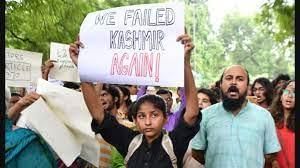
Why in News?
- The Supreme Court recently assured that special constitutional provisions protecting the interests of northeastern states under Article 371 will remain untouched.
- As the Constitution Bench deliberates the challenge to Article 370’s abrogation in Jammu and Kashmir, we delve into the significance of these assurances and their implications.
What is Article 371?
- Article 371 of the Indian Constitution grants special provisions to various states to protect their unique cultural and tribal identities.
- These provisions are aimed at preserving local customs, social practices, and land ownership.
Preserving Tribal Culture
- Context: Article 371 provides special provisions for several states, particularly in the northeast, to safeguard their tribal cultures and unique identities.
- Article 371(A) – Nagaland: Article 371(A) ensures that acts of Parliament do not apply to Nagaland concerning Nagas’ religious and social practices, customary law, civil and criminal justice based on Naga customary law, and land and resource ownership.
- State Assembly’s Role: These provisions only apply to Nagaland after the State Assembly passes a resolution to that effect.
- Development Impediment: Some stakeholders, like Neikiesalie Nicky Kire of the NDPP, argue that Article 371(A) hampers development by preventing the government from carrying out development activities due to landowner preferences.
Similar Provisions in Other States
- Article 371-G – Mizoram: Similar to Nagaland, Article 371-G provides special provisions for Mizoram to protect Mizo religious and social practices, customary law, civil and criminal justice, and land ownership.
- Article 371B – Assam: Article 371B facilitates the creation of the sub-state ‘Meghalaya,’ aiming to provide special provisions with respect to Assam.
State-Specific Provisions
- Article 371C – Manipur: This article addresses special provisions for Manipur, a state that was formed in 1972.
- Article 371F and 371H – Sikkim and Arunachal Pradesh: These articles discuss special provisions for Sikkim and Arunachal Pradesh, respectively, to address their unique needs.
- Article 371 – Separate Development Boards: Article 371 empowers the President to establish separate development boards for specific regions within Maharashtra, Gujarat, and Andhra Pradesh, promoting balanced growth.
Further State-Specific Provisions except NE
- Articles 371D and 371E – Andhra Pradesh, Karnataka, Goa: These articles provide special provisions for these states to ensure their cultural and economic development.
- Articles 371J and 371I – Karnataka and Goa: These articles grant special provisions to Karnataka and Goa, respectively, to address their specific requirements.
Source: HT
India backs BRICS expansion: PM

Why in News?
India, a key member of the BRICS group (Brazil-Russia-India-China-South Africa), has affirmed its endorsement for the bloc’s expansion based on consensus.
Embracing BRICS Expansion
- Indian Support: PM Modi reiterated India’s full support for the expansion of BRICS membership, emphasizing the need for consensus.
- Collaborative Approach: Modi highlighted the potential for increased collaboration between BRICS countries in fields like space, education, and technology, using India’s expertise as a basis.
- Shared Platforms: Modi offered to share India’s technological platforms with other BRICS members, fostering a cohesive and future-ready organization.
BRICS’ Evolution and Vision
- BRICS Progress: Modi recalled BRICS’ journey, from being defined as “Building Responsive, Inclusive and Collective Solutions” during India’s chairmanship in 2016 to its current vision of “Breaking barriers, Revitalising economies, Inspiring innovation, Creating opportunities, and Shaping the future.”
- Chinese Perspective: Chinese President expressed support for speedy expansion to enhance global governance’s fairness and equity. He emphasized the enthusiasm of developing nations in joining BRICS cooperation.
Ongoing Deliberations on Expansion
- South African Insight: South African President Cyril Ramaphosa noted that discussions on BRICS expansion are ongoing, suggesting that a clear solution will be reached collectively among BRICS leaders.
- Indian Initiative: India’s approach to BRICS expansion was guided by the inclusion of strategic partners as new members, emphasizing consensus and unstructured discussions during leaders’ retreats.
Enhancing BRICS Cooperation
- Modi’s Proposals: Modi emphasized collaboration in space, technology, digital infrastructure, and education among BRICS members.
- BRICS Space Exploration Consortium: Modi proposed creating a Brics space exploration consortium for research and weather monitoring.
- Education and Technology: Modi cited India’s innovative solutions like Diksha and Bhashini for education and the CoWIN platform for vaccination, offering to share these platforms with BRICS partners.
- Skill Mapping and Conservation: Modi proposed skill mapping and cooperation for the preservation of various species of big cats found in BRICS countries.
- Support for African Union: Modi sought BRICS states’ endorsement for India’s proposal to grant the African Union full membership in the G20, reflecting shared commitment and unity within the group.
Conclusion
- As India reaffirms its backing for BRICS expansion, the group’s shared vision of inclusive growth and equitable global governance is reinforced.
- PM Modi proposals highlight the potential for collaboration in diverse domains, harnessing India’s technological prowess to foster a forward-looking and cohesive BRICS organization.
- Amid evolving global dynamics, BRICS’ united stance and collaborative efforts stand to reshape the landscape of international cooperation and equitable development.
Source: The Indian Express
GS-III
Chandrayaan-3’s Success: Future Objectives
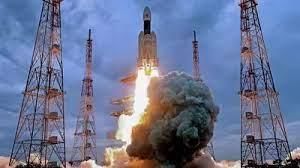
Why in News?
- As Chandrayaan-3 succeeded on its lunar soft landing, its six-wheeled rover begins a journey to unravel the mysteries of the Moon.
- With its payloads and instruments, the mission aims to build on the knowledge gained from its predecessors, investigating lunar quakes, mineral compositions, and water-ice presence.
Chandrayaan-3 Mission: Journey post soft landing
- Rover’s Arrival: The 26-kg rover, launched from the Chandrayaan-3 lander, is poised to cover up to 500 meters, commencing its lunar exploration.
- Duration: The lander and rover, equipped with six payloads, are primed to collect valuable data during the single lunar day (equivalent to 14 Earth days) of operation.
- Studying Lunar Quakes: The Chandrayaan-3 mission seeks to deepen insights into lunar quakes, expanding on the knowledge gained from its predecessors.
- Mineral Composition: The rover’s endeavors include examining the mineral compositions of the Moon’s surface, shedding light on its geological history.
- Electrons and Ions Study: The Radio Anatomy of Moon Bound Hypersensitive ionosphere and Atmosphere (RAMBHA) payload aims to study the behavior of electrons and ions near the lunar surface over time.
- Thermal Properties: Chandra’s Surface Thermo physical Experiment (ChaSTE) will explore the thermal characteristics of the Moon’s Polar Regions.
- Lunar Seismic Activity: The Instrument for Lunar Seismic Activity (ILSA) endeavors to measure lunar quakes and study the Moon’s crust and mantle composition.
- Laser Retroreflector Array: A passive experiment by NASA, the LASER Retroreflector Array (LRA), will serve as a target for precise laser measurements in future missions.
- Chemical Insights: The LASER Induced Breakdown Spectroscope (LIBS) aboard the rover is designed to identify the chemical and mineral composition of the lunar surface.
- Elemental Analysis: The Alpha Particle X-ray Spectrometer (APXS) aims to analyze elements such as magnesium, aluminium, silicon, potassium, calcium, titanium, and iron in lunar soil and rocks.
- Mineral Mapping: The CLASS X-ray Fluorescence experiment, covering nearly 95% of the lunar surface, offers detailed mineral mapping. Oxygen-rich minerals hold potential for future missions as fuel resources.
Earlier Chandrayaan: Pioneering discoveries
- Water Unveiled: Chandrayaan-1 played a pivotal role in uncovering the presence of water and hydroxyl molecules in the Moon’s atmosphere and surface, particularly in its southern polar regions.
- Subsurface Water-Ice: Payloads like mini-SAR and Moon Mineralogy Mapper (M3) detected subsurface water-ice deposits within craters near the lunar South Pole.
- Lava Tubes for Habitability: Terrain mapping on Chandrayaan-1 unveiled buried lava tubes that could provide protective habitats for humans, shielding against radiation and extreme lunar conditions.
- Magma Ocean Hypothesis: M3 payload data suggested the possibility of a past magma ocean on the Moon, pointing to its formation and evolution.
- Active Moon: Contrary to previous notions of lunar inactivity, Chandrayaan-1 revealed dynamic lunar processes, including volcanic activity evidenced by lava channels and vents less than 100 million years old.
- Surface-Exosphere Interaction: Measurements indicated that the lunar surface interacts with the exosphere, evident in the emission of carbon dioxide and other gases.
- Solar Mysteries: The Solar X-Ray Monitor on Chandrayaan-2’s orbiter observed solar microflares outside active regions, providing insights into coronal heating mysteries.
Conclusion
- Chandrayaan-3’s scientific journey exemplifies India’s dedication to unraveling the Moon’s mysterious nature.
- As data pours in from its payloads and instruments, the mission builds upon its predecessors, propelling our understanding of lunar geology, composition, and mysteries.
Source: The Hindu
Microsites project

Why in News?
Recently, the National Health Authority (NHA) announced 100 Microsites projects for accelerated adoption of the Ayushman Bharat Digital Mission (ABDM) across the country.
About Microsites project
- These are defined geographical regions where focused outreach efforts would be made to onboard small and medium-scale private healthcare providers.
- Types of facilities to be covered under a Microsite:
- Private facilities such as standalone clinics, polyclinics, nursing homes, small hospitals (preferably <10 beds), labs, pharmacies, and any other healthcare facilities wherein health records are generated.
- Health Facilities and Health Professionals from all the systems of medicine.
- Categories of a Microsite: Any State/UT can choose to implement any of the following categories of Microsites as per the regional priorities.
- Category A Microsite: A microsite which consists of at least 1000 facilities, inclusive of all types of health facilities, as mentioned above
- Category B Microsite: A microsite that consists of at least 500 facilities but less than 1000 facilities, inclusive of all types of health facilities, as mentioned above.
- Implementation:
- These Microsites would be majorly implemented by State Mission Directors of ABDM, while the financial resources and overall guidance would be provided by NHA.
- An interfacing agency under this program will have an on-ground team to reach out to the healthcare providers in the area.
- This team will spread awareness about the benefits of ABDM. It will help the service providers to join the core registries under ABDM, besides promoting the use of ABDM to enable digital solutions for regular clinical documentation.
- Patients will be able to link the health records generated at these facilities with their Ayushman Bharat Health Accounts (ABHAs). They will be able to view and share these records using any ABDM-enabled Personal Health Record (PHR) application on their phones.
Source: PIB
|
38 videos|5288 docs|1117 tests
|
















